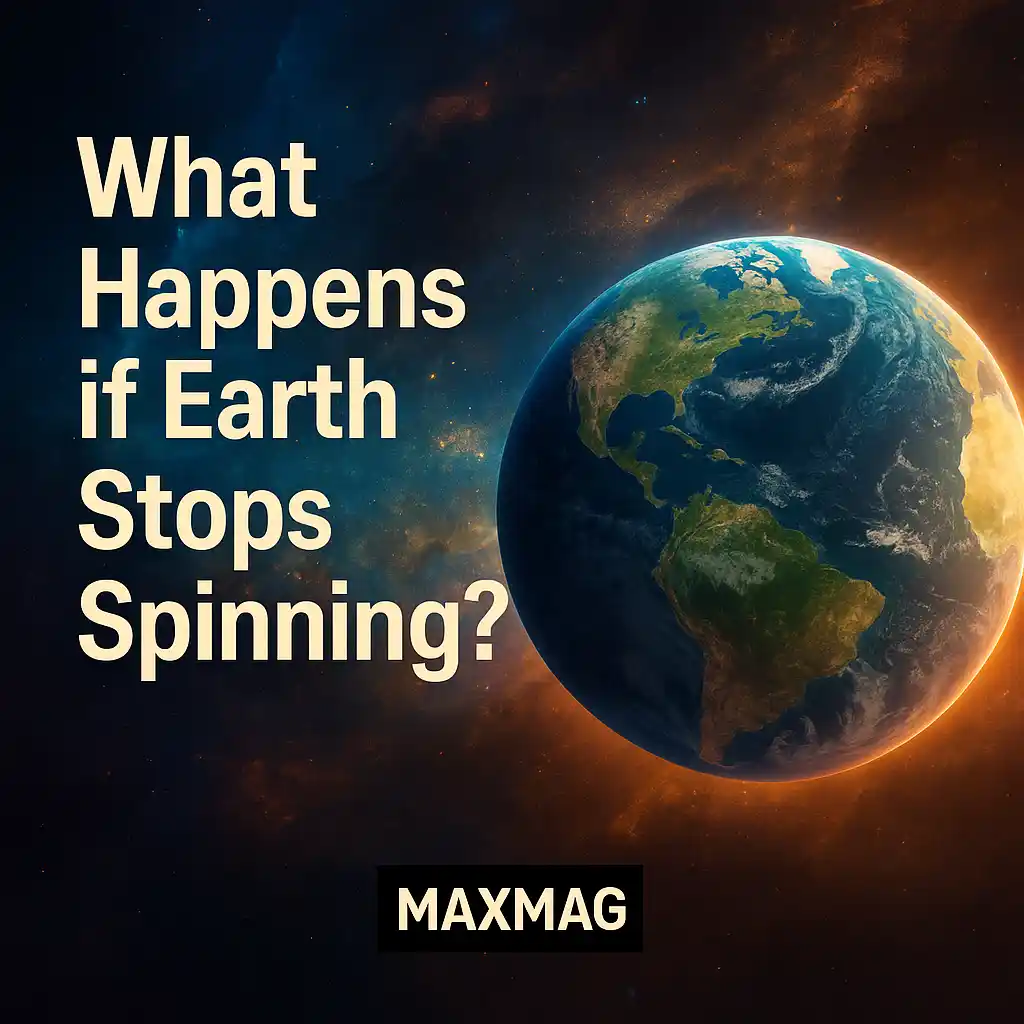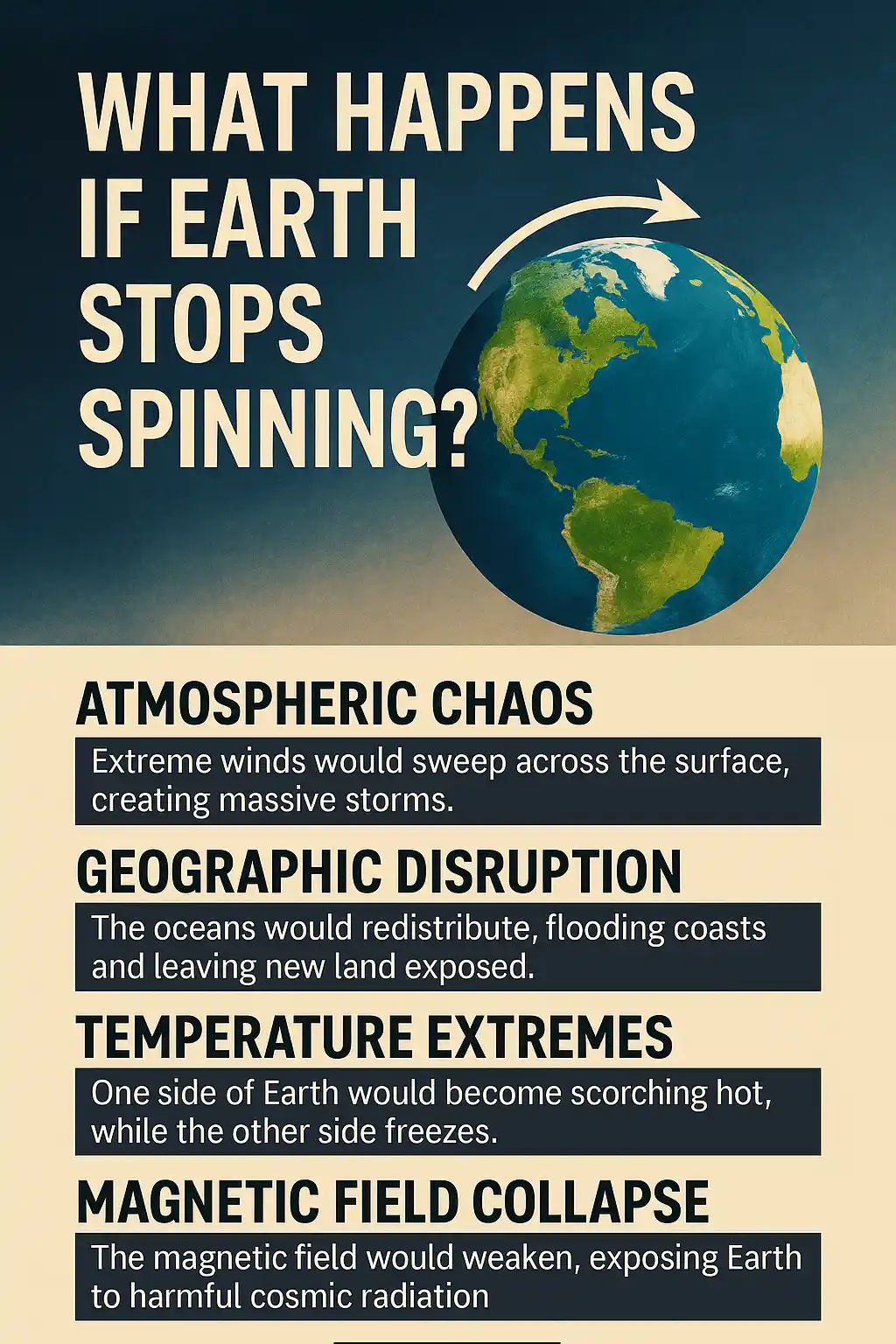
From the moment we wake up to when we fall asleep, Earth’s rotation quietly choreographs everything we know—sunrises, time zones, tides, and weather. But what happens if Earth stops spinning? What if, in an instant or over eons, our planet slowed down and came to a standstill?
This isn’t just a question for daydreamers or sci-fi fans. Scientists have asked it, too—and the answers are both fascinating and frightening.
Why Does Earth’s Spin Matter So Much?
Earth spins on its axis at a breathtaking 1,040 miles per hour (1,670 km/h) at the equator. That motion keeps things steady. It regulates daylight, balances global temperatures, and even shapes the paths of hurricanes. If you’ve ever wondered why clouds spiral or why trade winds follow certain patterns, it’s because of Earth’s rotation.
Take that spin away, and things begin to unravel. That’s what we’ll explore in this deep dive into what happens if Earth stops spinning—our focused keyword that anchors this entire article.
What Happens If Earth Stops Spinning?
There are two ways this scenario could play out. One is sudden—a total stop in a split second. The other is gradual, with Earth slowing over millions of years. Either way, the outcome would be life-altering. Let’s take a closer look.
1. A Sudden Halt: The Day the World Threw Us Off
If Earth’s rotation were to stop instantly, the momentum would be catastrophic. Imagine everything on the surface—people, oceans, buildings—continuing to move at over 1,000 mph while the ground beneath stops. It would be as if a car slammed the brakes at full speed.
-
Skyscrapers would topple.
-
Oceans would surge in massive tsunamis.
-
Anything not anchored deeply would be hurled eastward.
The destruction would be global. According to Scientific American, the atmosphere wouldn’t stop right away either. That means 1,000 mph winds tearing across the planet, scouring everything in their path.
2. No More Day or Night as We Know It
Let’s say Earth doesn’t stop suddenly, but slows to a standstill over time. In this case, we wouldn’t be flung off the planet, but we’d be stuck in strange new conditions.
One side of the Earth would face the sun at all times. The other would be cast into never-ending darkness.
-
Daylight areas could reach temperatures hot enough to vaporize water.
-
Night regions would freeze over, colder than the coldest nights in Antarctica.
-
The only bearable place to live might be the area in between—where day meets night.
This “twilight strip” might support life, but extreme storms would batter it due to massive temperature differences.
3. Say Goodbye to the Magnetic Field
Deep within our planet, the rotating molten iron core generates a protective magnetic field. It’s like Earth’s invisible armor, shielding us from solar radiation and cosmic rays. But no spin means no magnetic field.
That could lead to:
-
A thinning atmosphere, gradually stripped away by solar wind.
-
Increased radiation on the surface—dangerous for humans and electronics.
-
GPS, satellites, and communications systems breaking down.
As reported by NASA, even small shifts in Earth’s magnetic field can have widespread effects. A total collapse would make everyday technology unreliable, if not useless.

4. Oceans Would Relocate—and Not in a Good Way
Right now, Earth’s spin creates a slight bulge at the equator—water is pushed outward due to centrifugal force. Remove the spin, and that force disappears. Gravity would pull the oceans toward the poles.
-
Coastal cities near the equator could find themselves high and dry.
-
Polar regions might flood with newly arriving water.
-
Entire countries could lose their coastlines, while others drown.
Major population centers like Jakarta, Lagos, and even Miami could be underwater—or landlocked. This change would be slow but irreversible.
5. A Heavier Feeling: Gravity Without Spin
Without Earth’s rotation pushing us outward, we’d feel slightly heavier. At the equator, centrifugal force currently reduces the effect of gravity by about 0.3%. That’s not a huge difference, but it’s enough to notice over time.
-
Your weight would increase by a couple of pounds.
-
Heart and circulation systems might need to adjust.
-
Buildings and infrastructure would be designed differently to handle the change.
Animals, especially ones adapted to lighter weight at the equator, might suffer more from the added pressure.
6. One Year = One Day
Earth’s rotation gives us the 24-hour day. Without that spin, a full day would stretch out across a full orbit—meaning one year equals one day.
-
The side facing the sun would endure months of heat.
-
The opposite side would remain in freezing darkness for half a year.
-
Agriculture, human sleep cycles, and daily routines would be thrown into chaos.
People would have to develop artificial environments just to survive. We’d need to engineer light, warmth, and food systems independent of nature’s rhythm. You can read more about how time and light cycles affect us at National Geographic.
Could This Really Happen?
Not anytime soon. The planet is slowing down, but at a glacial pace. Due to gravitational interactions with the Moon, each century adds about 1.8 milliseconds to the length of a day. It would take billions of years for Earth to grind to a full stop naturally.
So while the question what happens if Earth stops spinning is mostly theoretical, it offers a stunning look at how intricately our world is stitched together by motion.
Why This Matters
We tend to take Earth’s spin for granted—rarely stopping to think about how much it controls. But the truth is, life as we know it depends on that silent, steady rotation. Losing it would unmake the world in ways we can barely imagine.
Understanding these big “what ifs” isn’t just about curiosity. It helps us grasp how delicate our planetary balance really is.




